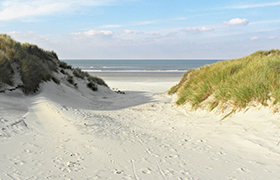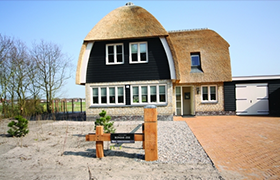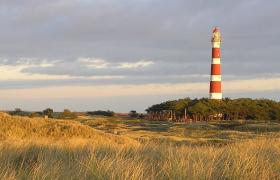Ameland
Welcome on Ameland
A day on the island is never the same. Ameland is directed by wind, water and tides. It might be a little cocky, but that is precisely the charm of this “Wadden” diamond.
Nes makes you curious.
The vibrant village of Ameland is a starting point par excellence. A village that was once dominated by though commanders. Captains of whaling expressed their stamp on the street scene. Characteristic houses from the 17th and 18th century still breathe the heyday of the hunting the Northern polar seas. Tip: have a look at the 'muizetandjes' in the façades. Two ledges with pointed pebbles in the home of a commander, one row less for the helmsman. Protected village face. No wonder. But Nes is much more than historical tribute. A colourful melting pot of island residents and guests. Atmosphere sketches of a glorious past hooks on to vivid, contemporary entertainment effortlessly. Search for a randomly terrace, order a coffee and a herbs bitter, which is some exciting brew of the house. Generous terraces – thanks to smart heaters, all year round busy- offer more local specialities.
Pubs and cosy places for a trendy bite or exclusive dish, bars and clubs to dance all night and a selection of surprising shops where you can shop all day. Watching and being watched, eating a fresh ice cream, buying a newspaper and a postcard. Souvenirs with a taste of Ameland: bread made of the grist mill or something distilled in a bottle. Highlights: enough of ancient churches to breathtaking views. Explore the Vleyen or admire the two jaw halves of a blue whale. The proud tower in the heart of Nes, once a beacon for shipping or the rough dune landscape. And find inspiration in the nature centre of Ameland where there is interaction for young and old with undoubtedly the highest vantage point of Nes.
Hollum exceeds in highlights. Literally.
Choirs-and mustard mill 'de Verwachting' is such an eye catcher of format, like the reformed church. A monumental church from the 14th century. Or take the brilliant light of the lighthouse. This cast-iron giant impresses from far, with its 58 metres height. The proud beacon watches on the west point over the island and on the shipping. The climb? Which is tangy- 236 spiral stairs- but absolutely worth it. The well-preserved historical heart of Hollum still breathes a maritime past. In the beautiful Commander's houses that shelter together. Houses as those of captain Pieter Cornelis Sorgdrager, converted into a museum that still bears his name honourably. Also the oldest house of Ameland (1615) is located in the centre of Hollum.
Behind many of these stone façades lurks world stories. Stories about hostel 'de Zwaan', with its gentleman room in rococo style. Stories about fearless rescue workers and their temperamental helpers in the surf: horses. At the end of the 'Reddingbootpad' you find the gravestone for eight of the horses. The animals were killed at a rescue mission in the summer of 1979. Stories. Hollum has them in abundance. Of the full figured whaler 'Hidde Dirks Kat' who is burried in Hollum out of necessity: his heavy body couldn't be moved after he died in 1824. A wealth of stories is bundled in the brand new Maritime centre, with its characteristic boat house and interactive features for modern guests. And they taste for more.

Buren is a special village.
In Nes, Hollum and Ballum lived mainly sailors, but in the most eastern part of the island mainly farmers. Still dominates the agricultural sector: Buren is surrounded by dunes and meadows with cows and sheep. However, Buren did develop. The cosy village heart is formed by shops, cafés and welcoming terraces, who vouch for cosy liveliness. Symbol for the glorious scuttle past a bronze statue at the village square is situated. It is the effigy of the maligned 'Rixt van het Oerd' fishermen widow, who lived from beach finds. A fluttering cape around her frail figure, a storm lantern in het left hand.
'Rixt van het Oerd' plays the starring role in the main legend of Ameland. She lived with her only son 'Sjoerd' in a simple hut at the 'Oerd', a no-man's-land of salt marshes, mudflats, sand sheets and dunes They lived from what drift ashore. After her son, on a black day, had decided to become a sailor Rixt remained alone. The sea was becoming less generous, poverty tormented the widow. That is why she decided to help fate a hand by climbing the 'Oerdblinkert' at a stormy night and give light signals with her lantern. Far at sea a captain suspected a safe haven, therefore he returned the stem but ran to smithereens on the coast. When the next morning 'Rixt' was looking for booty she found the lifeless body of her own son. Hysterically she run into the dunes. She's never been seen, but occasionally, when its stormy, you can still hear her screams miserably: Shu-oe-oe-oerd...!! Also the story of the agriculture hasn’t ended yet, as to this day much agricultural activity is happening, but who want to visit the past cannot skip a visit to 'Jutters Museum Swartwoude'. It displays an appealing picture of the often wretched conditions of the 'Amelander' farmers in the 19th century.
A walk through Ballum is a walk through history.
Here, ruled from their mighty lock, ever-from the beginning of the 15th to the second half of the 17th century-the 'Cammingha's' with penalty hand over the island. The 'Camminghastraat' reminds still to this 'Lords of Ameland'. The authentic village character of this modest core is preserved to this day. Logical that Ballum is a protected village. Beautiful buildings, whose age carves on the rusty wall anchors, dominate the street scene. Eye-catcher is without any doubt the of yellow stones erected tower, a few metres from the reformed church. Nowadays hotspot for tourists, but centuries ago a place where villagers came together if there was right. Because the tower topped the scourge and pillory drawn up. Corporal punishment as public entertainment.
Because of the historical character Ballum is a must for every island visitor. Just take a look in one of the two churches, snuff to a touch of history in the cemetery behind the town hall. The floor of the cottage is formed by the beautifully sculpted seem gravestone, who closed the burial of the 'Cammingha's'. A shells border around the house, marks the old foundations, who ever belonged to the demolished slot in 1829. In the leafy heart of the village go effortlessly trendy and traditional hand in hand. Guests sipping carefree of a 'Nobeltje' (the 'house drink' of Ameland), wander through a museum full of nostalgia or enjoy outdoor activities. Because the airport is located just outside Ballum, always setting for a special activity. A guided flight, skydiving or gliding. Everything is possible!



















